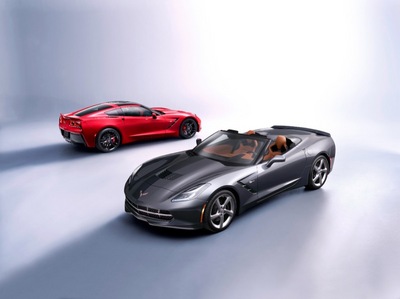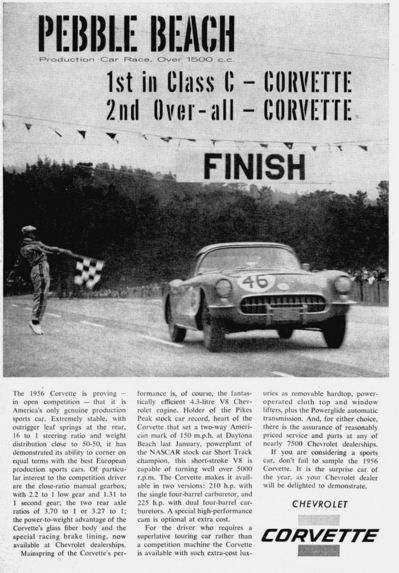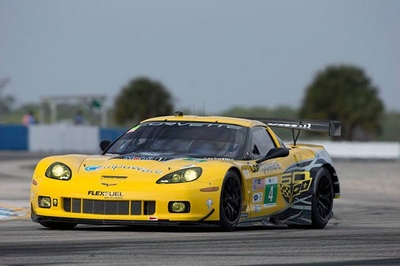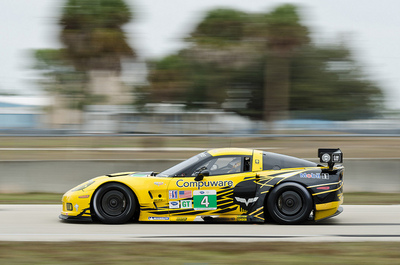My Generation: Benign Neglect

by Rick Tavel
Special to Corvette Forum
? 4-29-2013 All rights reserved
While
recovering from some surgery, I had the opportunity to catch up on reading
that I had neglected over the past weeks. Since I am in the midst of writing a
multi-part article on the advertising history of the Corvette, one commentary
written by Peter De Lorenzo, better known as the ?autoextremist?, immediately
captured my attention, ?Marketing the Corvette: What GM Doesn’t Get?. Peter De
Lorenzo is the founder of Autoextremist.com,
and appears with legendary automotive journalist John McElroy on the weekly TV
series ?Autoline Detroit?. I try to make
a point to read his ?commentaries? regularly?he calls them ?Rants? which is
probably a more accurate description of his column. The rants are obviously controversial, and
controversial usually equates to interesting, if not thought provoking. Whether the reader agrees or disagrees with
his latest topic, they almost always require consideration and provoke
thought. So if you are an enthusiast who
doesn’t want to read the regurgitated BS that some journalists (those who have
drunk a little too much of the manufacturers? kool-aidTM) try to
pass off as fact, then you should put De Lorenzo on your reading list (www.autoextremist.com).
Anyway back on point, De Lorenzo’s article (specifically his ?Rant? of January 23 ?Marketing the Corvette: What GM doesn’t get.?) makes some interesting observations about the way General Motors has taken for granted their most legendary car, particularly in the way they market the Corvette. DeLorenzo chastised GM for way the marketing department often overlooked if not flat out ignored their halo car except during a new generation unveiling. Though I do not agree with part of his solution which would require the Corvette to break away from Chevrolet and become its own brand, encompassing several different models (similar to Porsche), and becoming a true global brand. I do agree, that the Corvette has been neglected by GM’s marketing department for decades. As I understand it, some of the marketing folks at GM were not too pleased about what De Lorenzo said, even though he was highly complementary of the new C7 Corvette and has praised it in several commentaries and interviews.
The Corvette marketing strategy that De Lorenzo attributes to GM’s marketing gurus reminds me of a management style that is frequently encountered when a manager is unqualified for their responsibilities. The management style is known as ?benign neglect?. Simply it is the technique of managing by completely ignoring the project or objective and letting fate determine outcome.
Tim Mahoney
The Corvette’s neglectful marketing is certainly not new and has little to do with the obvious confusion and lack of direction that currently characterizes the marketing department at GM. Certainly it is apparent that things need to change and recognizing this may be the impetus that prompted GM’s dynamic president, Mark Reuss, to shake things up and appoint a new head of Global Marketing as well as beginning the search for new marketing firms to turn things around. Reuss recently named Tim Mahoney, formerly of VW, Subaru and Porsche, to head up global marketing beginning in April. Hopefully, Mahoney will be able to right the badly listing marketing ship at GM. Already, new advertising agencies are being reviewed and some have even been appointed. After being terminated by former Marketing Chief Joel Ewanick, who himself was ousted last year, it looks like long time ad agency and partner of Chevrolet, Campbell-Ewald, will be returning to take over Cadillac’s advertising and former Cadillac/GMC agency McCann Erickson will be taking on the Chevrolet account. Ewanick seemed to have difficulty grasping and marketing the ?essence? of the GM brands. In fairness to Ewanick, the marketing department was in disarray even before he assumed the reigns. But under his guidance there were some marketing disasters and it appeared the job was simply too big for him. It looks like Reuss has put the right person in place, at least from a qualification and results perspective. Hopefully, Mahoney and Chevrolet’s new agency will recognize the opportunities that exist not only throughout the marketing department but in the Corvette itself.

Up until the mid 1970’s, the Corvette was effectively advertised and marketed. Some of the best advertising in the industry was generated by Campbell-Ewald for Chevrolet and the Corvette. From the ?Child of the Magnificent Ghosts? ads that helped introduce the new Corvette to the ?Baseball, Hot Dogs, Apple Pie and Chevrolet? theme which won several awards, the sports car received its fair share of marketing. The Corvette was not only directly advertised effectively in print but was also marketed subliminally. The car appeared regularly on several TV shows and even had an entire series built around the car, ?Route 66?.
But even as early as the 1960’s the seeds of neglect were being sewn. A key Campbell-Ewald executive that worked the GM account revealed that ?they [GM executives and marketing managers] simply didn’t care about the car. It wasn’t important to them. In the big picture the car did not produce enough to matter.? Sure in its infancy Chevrolet nursed the new car along. Clearly the car received the funding necessary to promote it, to get it in front of consumers. That same CE executive went on to say that the ?competition advertisements in the mid to late fifties were especially effective. Duntov had pushed for the car to compete at the track and for us to advertise their victories. It was the Race on Sunday, Sell on Monday theory. It worked.?
So once the car became internationally recognized as a true sports car the sales quickly followed. But the burgeoning sales fostered an attitude and unspoken marketing strategy that has prevailed within the marketing department for decades?why should we spend money advertising and marketing a car that sells itself? The unspoken strategy was reinforced and solidified in the 1970’s as a way to help improve the corporation’s sagging profit (even though the contribution was almost imperceptible) due to the gas crisis and quality problems which presented a monumental challenge to the corporation. And maybe the ?bean counter? inspired cuts in marketing helped briefly, when the Corvette was the only game in town. But like so many temporary corporate cutbacks, after a while they became permanent, and have allowed the Corvette to be marketed neglectfully ever since.
First and foremost, GM’s management has to recognize the sales and profit opportunities of marketing the Corvette as a ?brand enhancer? not only for models in North America but worldwide. The Corvette is a world class car and GM’s undisputed halo model. As such, no other car in the stable effectively influences the sales of so many other Chevrolet models. Every first year marketing student learns about the customer predilection for looking at the red Corvette in the showroom and then buying an economy model. There is probably no better example of the perfect brand enhancer. We may never know how many other GM products are purchased because of the Corvette and what it represents but clearly it is a significant number and with virtually no marketing to the masses! Logically, it follows that by properly marketing the Corvette, sales of other GM products, specifically Chevrolet are enhanced.

This applies not only to the American market. As most of us ?true believers? are aware, GM now envisions the C7 as a global car. I won’t go into how the concept of globalizi
ng the Corvette has affected its design. You can read about that in a previous My Generation article, ?To Buy or Not to Buy and the Disappointment of Global Marketing? (CorvetteForum? April 1, 2013). Using the C7 as a brand enhancer in marketing the car globally could have a major impact on the disastrous European market where GM loses billions of dollars. Not so much by selling thousands more Corvettes abroad but rather by linking other models to the potent Corvette. Coupling this effort with the Cadillac ?V? cars would make a big impact on other less expensive but profitable models. The marketing department at GM has to stop ignoring the potential of the Corvette as a marketing tool and take responsibility for building an effective marketing program around the car. With the recent introduction of the new C7, along with the arrival of a new Global Marketing chief, there is no better time to step up and make it happen.
This isn’t the first time the debate about brand advertising has come up at Chevrolet, nor is it the first time using the Corvette in brand advertising has been disputed. The idea was pitched to John DeLorean and other GM execs in the 1970’s. Though DeLorean could see the obvious benefits, the idea was shot down in favor of using the marketing budget to advertise specific, more profitable models. A former Campbell ? Ewald advertising executive (now retired), who wishes to remain anonymous, was very involved in Corvette advertising in the 1950’s through the 1980’s tried to explain the negligible marketing since the 70’s, ?The car was successful. It was the only American sports car and it was selling. After that, in terms of sales volume it was insignificant to most of them (GM executives) and it seemed like they didn’t have the time, money or inclination to spend on it. In the beginning the car got plenty of advertising and money thrown at it. But after we got the car on its feet, off and running, it certainly never got the advertising budget it deserved, especially in relation to other cars.? He went on to explain that there were other reasons for neglecting the Corvette’s marketing, among them the debate within the marketing division about where the budget should be spent.

Then there was the disastrous gas crisis in the early seventies which required almost everyone’s complete attention. “I can’t tell you the time and effort put into the new Vega which was being headed up by John DeLorean. Chevrolet needed this car, especially due to the public’s shift to economy cars because of the gas crisis. We even put together a separate group at the agency [Campbell-Ewald] to handle it. John DeLorean headed up the Vega. When he moved to Chevrolet he was usually ‘sideways? to other GM executives, especially when it came to the marketing department at GM.” DeLorean, unlike most GM executives, favored the need for brand advertising. He realized the benefits of a strong brand advertising program, even though it was not necessarily tied to the Corvette. During the seventies most GM executives and, as a result, the marketing department was committed to individual model advertising and did not advocate using brand advertising to support the overall effort. That was one reason the ?Baseball, Hot Dogs, Apple Pie, and Chevrolet? was never even close to its potential or even developed into a print ad campaign. The powers that be at GM viewed the ad as brand advertising and relegated to only limited use as a theme. The BB, HD, AP & Chevrolet ad theme won several awards and David Ogilvy stated that the theme, developed by Jim Hartzell, was not only the best automobile commercial but the best commercial he had ever seen. But marketing was opposed to brand advertising and as a result they never exploited it and built a complete advertising effort around it.
Maybe there is no better time than now, following the major introduction of a new generation of Corvette, to compare just how invisible Corvette marketing is at other times. Recently we have actually seen a few teaser ads for the launch but ask yourself when was the last time the car received so much attention, even though the car has become one of the world’s most successful production car race teams in history. The car has won nine American LeMans Series manufacturers and team championships and eight drivers? championships.
What other automobile manufacturer would not use their competition track record to their advantage to market their cars. If you’re having trouble thinking of a comparison, look how Porsche publicizes their success on the track. Win on Sunday, sell on Monday. The Corvette won the Rolex Sports Car series early in March at the Circuit of the Americas in Austin but if you didn’t see the race, how would you know?

The 2012 season marks Corvette Racing’s 14th year in international road racing. Corvette Racing has become one of the world’s most successful production sports car teams, winning eight consecutive ALMS GT1 manufacturers and team championships and seven ALMS GT1 drivers’ titles. This year as I watched the 12 Hours of Sebring on Speedvision?, I couldn’t help but compare BMW’s and Porsche’s marketing with that of Team Corvette. There probably isn’t a better example of what I am talking about. I must have seen no less than eight Porsche commercials and five BMW commercials. Both companies capitalized on their performance background and/or racing heritage in their commercials and more importantly tied the competition cars on the track to the showroom version. Admittedly, they both have an impressive history and one to be proud of. But so does the Corvette and neither BMW’s nor Porsche’s competition results over the last decade compares to Corvette’s in GT racing. To add insult to injury, I even saw three SRT Viper commercials, for God’s sake! How many Corvette commercials were seen during this same period? None, Zero, Zilch. To be fair I did see a few Camaro ZL1 ads despite the fact there were no Camaros in the race. I even saw a Cruze commercial that was “finding new roads” but no Corvette, you know, the car that ended up winning the race in front of millions of TV viewers who were demographically Corvette’s target customer. Driven by Milner, the Corvette staged a brilliant comeback, after being considered all but out of the race due to an electrical glitch, and in a late race run drove the Corvette to a GT class victory.
Clearly, it appears all of the other competitors in the race understand the importance of reaching that target customer and enhancing the competition image of the car, something that eludes the marketing mavens at GM. This is
a typical example of the benign neglect that has characterized GM’s marketing department with regard to the Corvette for the last four decades. Furthermore, Tadge Juechter, the Corvette’s chief engineer, along with Harlan Charles, Corvette Product Marketing Manager were present to give their annual Sebring seminar, which is not only informative and interesting but a benefit that Corvette enthusiasts really appreciate. But to be a part of it, to hear it you had to be there and just how many enthusiasts can be there? If they ran the seminar on TV or taped it for rebroadcast on the web it would greatly help. But aside from snippets it’s just another missed marketing opportunity.
The evidence proves that the belief within GM that the Corvette sells itself, exists. One thing is certain though: the people responsible for marketing and selling this car better wake up. The performance car market is becoming more competitive by the month. Ford? has the Corvette in its sights with the development of the new Mustang GT500 due next year. The current 2013 Ford Mustang GT has already what many consider to be the best overall engine of any V8 and the 2013 Shelby GT500’s 5.8 liter engine pounds out 663 HP and impressively runs the ? mile in 11.6 seconds. Somehow I don’t think Ford’s marketing department is going to keep that a secret. The SRT Viper is clearly looking to avenge the humiliation the Corvette has bestowed on it in almost every category. We won’t even discuss Porsche’s efforts to attract that same demographic customer as Corvette, the difference is that Porsche will market their car effectively and not just let fate determine outcome. What’s that strategy called?.could it be benign neglect? The competition for the performance car customer is no less intense than the competition on the track and someone in GM’s marketing department better wake up and take ownership, take responsibility. It is pretty clear that GM’s marketing division needs a Tommy Milner to drive the Corvette marketing effort and put it on the podium.
Tags:
Campbell,
chevrolet,
chevy,
corvette,
De Lorenzo,
Ewald,
GM,
McCann,
racing,
Rick Tavel,
stingray
Related






